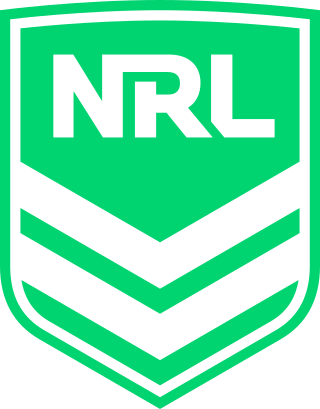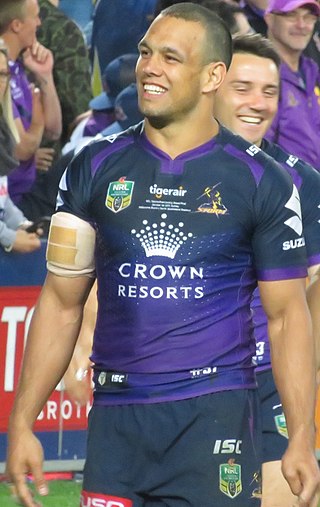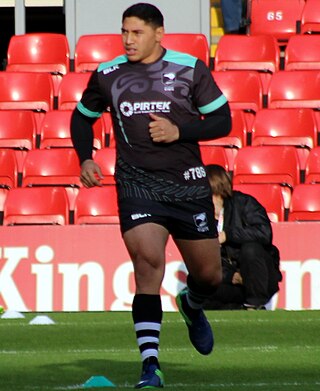
The National Rugby League is a professional rugby league competition in Australasia which contains clubs from New South Wales, Queensland, Victoria, the Australian Capital Territory and New Zealand.

The Adelaide Rams was an Australian professional rugby league football club based in Adelaide, South Australia. The team was formed in 1995 for the planned rebel Super League competition. The Rams lasted two seasons, the first in the Super League competition in 1997 and the second in the first season of the National Rugby League (NRL) in 1998. The Rams were not a successful club, winning only 13 out of 42 games. However crowd numbers in the first season were the fifth highest of any first-grade club that year, but dwindled to sixteenth in the second season. The Adelaide club was shut down at the end of the 1998 season as a result of poor on-field performances, dwindling crowd numbers, financial losses and a reduction in the number of teams in the NRL. They remain the only team from the state of South Australia to have participated in top-level rugby league in Australia.
Andrew "ET" Ettingshausen is an Australian former professional rugby league footballer who played in the 1980s, 1990s, and early 2000s. He played his first grade Australian club football for the Cronulla-Sutherland Sharks, retiring at the end of the 2000 NRL season having played 328 first grade games for the club, the NSWRL/ARL/SL/NRL record for most games at a single club. This record stood for ten years, before ultimately being broken by Darren Lockyer for the Broncos in 2010.
The 1997 Super League season was a breakaway professional rugby league football competition in Australia and the only one to be run by the News Limited-controlled Super League organisation. Eight teams which had broken away from the existing Australian Rugby League, in addition to the newly created Adelaide Rams and Hunter Mariners, competed over eighteen weekly rounds of the regular season. The top five teams then played a series of knock-out finals which culminated in a September grand final played in Brisbane between the Brisbane Broncos and Cronulla.
The history of the National Rugby League (NRL), the top league of professional rugby league football clubs in Australasia, goes back to December 1997, when it was formed in the aftermath of the Super League war of the mid-1990s. The NRL has, in its relatively brief history, enjoyed growth and record attendance figures.

Geoffrey Toovey, also known by the nickname of "Toovs" or "Tooves", is the former head coach of the Bradford Bulls and former professional rugby league footballer. Toovey played halfback for the Manly-Warringah Sea Eagles, then played as a hooker later in his career at the Northern Eagles. He played 286 first-grade matches in all, and captained Manly to the 1996 ARL premiership and the 1995 and 1997 grand finals. He played in 13 international matches for Australia between 1991 and 1998. Toovey is the former head coach of Manly-Warringah.
Paul Gregory Green was an Australian professional rugby league football coach, best known for taking the North Queensland Cowboys to the NRL premiership in 2015, and a professional rugby league footballer who played in the 1990s and 2000s.

The 1995 ARL premiership was the 88th season of professional rugby league football in Australia, and the first to be run by the Australian Rugby League following the hand-over of the Premiership's administration by the New South Wales Rugby League. For the first time since 1988, the Premiership expanded again, with the addition of two new clubs from Queensland; North Queensland Cowboys, based in Townsville, and South Queensland Crushers, based in Brisbane. And for the first time ever outside the borders of New South Wales and Queensland, and indeed, Australia, the addition of two other new clubs from Western Australia, Western Reds, based in Perth, and from Auckland, Auckland Warriors, based in Auckland. This saw a total of twenty teams, the largest number in the League's history, compete during the regular season for the J J Giltinan Shield, which was followed by a series of play-off finals between the top eight teams that culminated in a grand final for the Winfield Cup between the newly re-branded Sydney Bulldogs and the Manly-Warringah Sea Eagles.
Craig Greenhill is an Australian former professional rugby league footballer. He represented Queensland Maroons in State of Origin, as a second-row.

William Chambers is an Australian retired rugby league and union footballer who last played for the LA Giltinis in Major League Rugby (MLR) in the United States. After winning two titles with the Melbourne Storm, he retired from Australia's NRL in 2021.

Benjamin Barba is an Australian former professional dual code rugby league & rugby union footballer who last played for St Helens in the Super League. He primarily played as a fullback or five-eighth.
The Auckland Warriors 1996 season was the Auckland Warriors 2nd season in first-grade. The club competed in Australasia's Australian Rugby League competition. The coach of the team was John Monie while Greg Alexander was the club's captain.
Dunamis Lui is a Samoa international rugby league footballer plays as a prop and lock for the Redcliffe Dolphins in the Hostplus Cup.
Luke Phillips is an Australian professional rugby league football match official and former player. He started refereeing National Rugby League Premiership matches in 2010, having played seven seasons in the 1990s and 2000s as a goal-kicking fullback for the Sydney Roosters, Canberra Raiders, Manly Warringah Sea Eagles and North Queensland Cowboys.
The Super League war was a commercial competition between the Australian Rugby League (ARL) and the Australian Super League to establish pre-eminence in professional rugby league competition in Australia and New Zealand in the mid-1990s.

Vaai Taumalolo, better known by the nickname Jason, is a New Zealand professional rugby league footballer who plays as a lock forward for the North Queensland Cowboys in the National Rugby League (NRL). He has played for Tonga and New Zealand at international level.
1997 in rugby league centered on the Super League II and Australasia's split season.
The ARL Premiership was Australia's first grade rugby league competition between 1995 and 1997. It replaced the previous competition, the New South Wales Rugby League premiership, after the competition expanded to 20 teams with the admittance of four additional clubs to the competition; the North Queensland Cowboys, South Queensland Crushers, Western Reds, and Auckland Warriors.

Fa'amanu Brown is a professional rugby league footballer who last played as a hooker for the St. George Illawarra Dragons and has represented Samoa and New Zealand at international level. He played as a halfback, five-eighth and lock earlier in his career.
Top-level rugby league in 2014 centred on Australasia's 2014 NRL Auckland Nines, 2014 NRL season and the Super League XIX. High-profile representative competitions included the 2014 Rugby League Four Nations and the 2014 State of Origin series.









